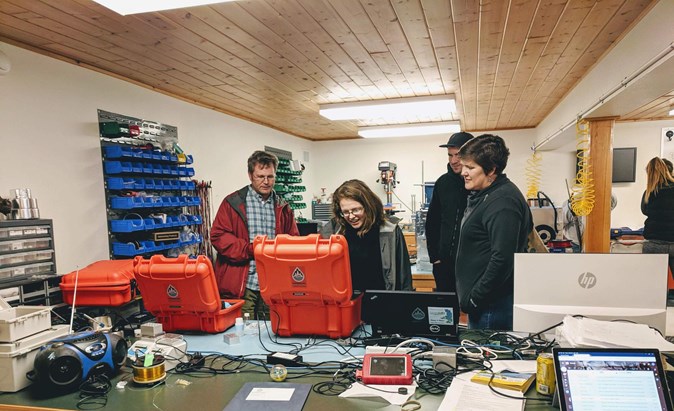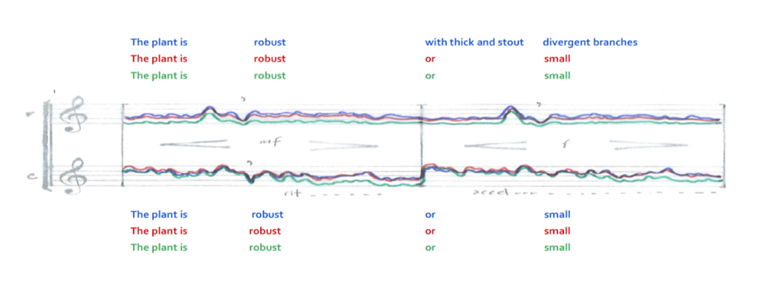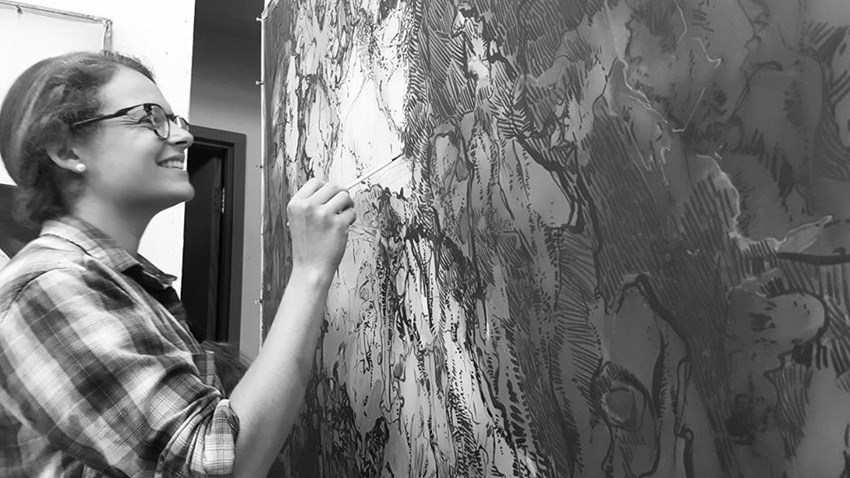Reflections from the Bio Station: A Q&A with 2019 OpenAIR MT Artist-in-Residence Anne Yoncha
About this interview: This interview, written and conducted remotely by OpenAIR MT, took place before the pandemic shutdown. Due to COVID-19, Anne was forced to return to the United States before completing the full term of her Fulbright. She will begin a university teaching position in Oklahoma in the Fall.

Anne Yoncha (center) explores equipment in the Sensor Space during orientation at the University of Montana Flathead Lake Biological Station.
Open AIR: Can you talk about your experience while in-Residence?
Anne Yoncha: The chance to work at Flathead Lake Bio Station (FLBS) was a dream come true. I started most days touring the labs, talking to researchers about their work--basically getting a crash course on everything from how zooplankton experience water resistance differently because of their small size, to the way lake-wide seiche waves are measured, to the history of the station. And then in the afternoon I would make work reacting to what I'd learned in my lakeside cabin studio. On either side were the studios of the other artists-in-residence, and it was so great to be able to pop outside and talk to Anne, Tessa, and Zach about what they were working on. It's energizing to work alongside other artists, especially when they have different processes, and here it was interesting to see how everyone processed all the new information in different ways. There was always time for a kayak or paddleboard in the bay, and watching sunset over the lake (including one very chilly swim). By the way, our other next-door neighbors were a bear and her cubs...
Open AIR: What was your research process during this time?
Anne Yoncha: I am really grateful I had the chance to work with the SensorSpace at FLBS. I'd used a few sensors in earlier work but thanks to Cory, Gary, and Zane, I got a lesson on how digital and analog sensing work differently, and got to see how they developed tailored sensor systems for research happening at the lake. Plus, I had the chance to work with a chemically-synthesized upconverting nanoparticle--the structure can take and store invisible light (like infrared), and then emit it as a visible beam. It's usually used in anti-counterfeit measures or cell imaging, but I mixed it with paint, so the works I made interacted with infrared light. I really enjoyed combining unusual materials on a 2D surface in this way, thinking about how a drawing or painting can share data in a new way--something I've continued exploring in Finland. I also really appreciated how the researchers at the station were so willing to answer our (many) questions. Since FLBS, I've also had the chance to work with scientists at Cedar Point Bio Station in Nebraska and at the Natural Resources Institute Finland--and I feel like OpenAIR helped me develop this way of working. I'm excited to start my new job at East Central University, where there will hopefully be opportunities to collaborate with the nearby Kerr Water Research Lab in Ada, Oklahoma.
Open AIR: What are you up to now post-residency?
Anne: I'm currently finishing a Fulbright fellowship working with ecologists in Finland. They have been conducting studies for the past 5 years on ways to restore former peat extraction sites, and I had the chance this year to make some work to help visualize the peatland ecosystem, which is otherwise hard to see--it only develops extremely slowly, at and under the ground, and in a few parts of the world. I had the chance to use a hyperspectral camera, which can measure wavelengths beyond what we can see and what a regular camera can detect, giving us more information about water content and plant cell structure. I used the hyperspectral data in this case to make a graphic score to be performed musically--so we can hear changes in the soil structure before and after restoration. An image of part of the graphic score (in the tradition of artists like John Cage and Cathy Berberian), using a taxonomy of Finnish Sphagna species for the lyrics, is below:

Open AIR: Walk us through the choices you made in a particular artwork.
Anne: I think this depends a little on the piece, but my work generally begins with a question. For instance, in a work I made last year, Second Wind, I wanted to see if I could show the invisible forces on a tree, in real time, in a gallery. I thought about transpiration and wind especially as driving the way a tree survives drought (or doesn't).
Then, I try to look at each piece as an excuse to try out a new way of working, new materials or a new process. In this case, I wanted to develop a system which would translate the data from outside to inside, and finally settled on two Raspberry Pi single-board computers. I also start thinking at this point about how the audience experiences the piece, what they encounter first and their early impressions, and then how the information gets shared over time, how the piece conceptually unfolds. Since the work was happening away from the tree, I wanted to include some kind of "clue" pointing back to the referent, and I wanted that clue to also come, materially, from the tree. I started researching ink-making and found a centuries-old type of ink made from oak galls, where the tannins react to iron sulfate to make a rich, permanent black. I swapped in pine needles instead, and got a burnt sienna color which oxidizes and becomes darker over time. Since this piece I've experimented with lots of other variations on this recipe, and other ways of sourcing materials from site--including the hand-made paper in Finland.
Open AIR: Do you have any new projects in the works?
Anne: In September, I headed to Finnish Lapland for a residency at Kilpisjarvi Biological Station with Finland's BioArt Society. My team, High-Altitude Bioprospecting, used a heli-kite (a helium-filled kite) to collect biosamples from the air. We've recently gotten the PCR analysis of our samples back and are brainstorming ways to make work about our results. It's an especially interesting and important time to be thinking about microbes and how the movement of air connects us all.


